Decarboxylation is an important yet often misunderstood aspect of cannabis consumption.
Decades of prohibition have allowed incomplete, inaccurate, or just plain wrong information about decarboxylation to spread like wildfire through the cannabis community–hurting not only medicinal patients but the cannabis movement as a whole.
To shed light on this topic and combat false data, we’ve compiled our clinical research on decarboxylation in order to address the most common decarboxylation myths.
Our aim here at Ardent is to expand access to and promote the acceptance of cannabis for wellness and health-related issues. To accomplish this, we are committed to investing in research to disperse the myths while presenting the facts in an easy to process way.
This guide covers the 6 most common decarboxylation myths – make sure to download the FREE ebook below to share with friends!
First, What is Decarboxylation?
What is decarboxylation you ask? The process for decarboxylation is a function of time, temperature, and atmosphere. Ultimately, the goal is to fully activate the THC in your cannabis for a much higher potency than traditional methods of consumption (i.e. smoking) are capable of.
However, it isn’t as simple as sticking bud into an oven, toaster, crockpot, lighting it on fire, or even using the sous vide decarb method. Fully activating THC without destroying valuable cannabinoids is a precise and scientific process.
When done correctly, you get more out of your cannabis and also have infinite ways to use it. This is exactly why we developed a decarboxylator that encapsulates this complicated process and transforms it into a reliable tool that is discreet and easy to use at home. It is flexible, efficient, and easy to use.

We realized pretty quickly that many years of misinformation still left a lot of patients confused about decarboxylation and the right way to approach cannabis in general. Myths about medicinal vs psychoactive effects, the basics of how even begin to decarboxylate cannabis, and the inherent potential of processed vs raw cannabis circulate through online resources and cloud the heart of the issue: providing an effective, simple process of creating decarb cannabis.
Over time we’ve researched some of the top questions we’ve encountered and compiled answers for our consumers into this handy guide, allowing us to shed some light on some of the most common decarb myths to get the truth once and for all.
1. Fresh and Cured Bud Need Different Decarboxylation Methods
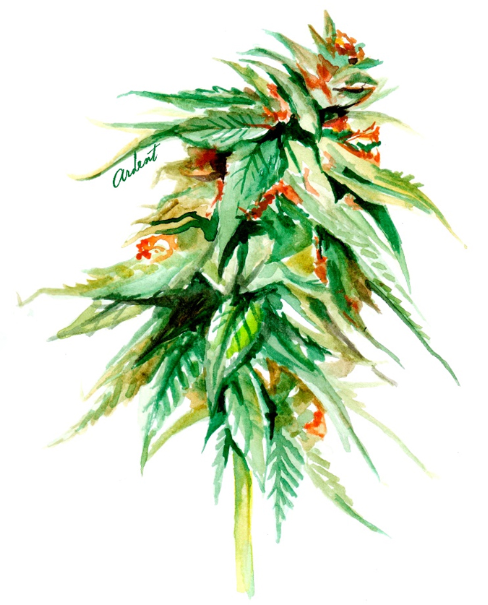
This myth takes a few different forms. Most people think “fresh and cured bud decarb at different rates” or “fresh bud won’t decarb – you have to remove the moisture.” While some others think that, “curing the bud decarbs it anyways, so why do I need to do anything after that?”
Each of these suggestions are myths.
Fresh bud can easily be decarbed in the right conditions. It’s a good way to preserve more terpenes in the final product (think about the smell of fresh vs. dried flowers and other plant material).
In a controlled setting, decarbing fresh bud takes the same amount of time as decarbing cured bud. Most importantly, properly cured bud does not go through the full activation when it is going through the drying and curing process that is required for the active decarboxylation process.
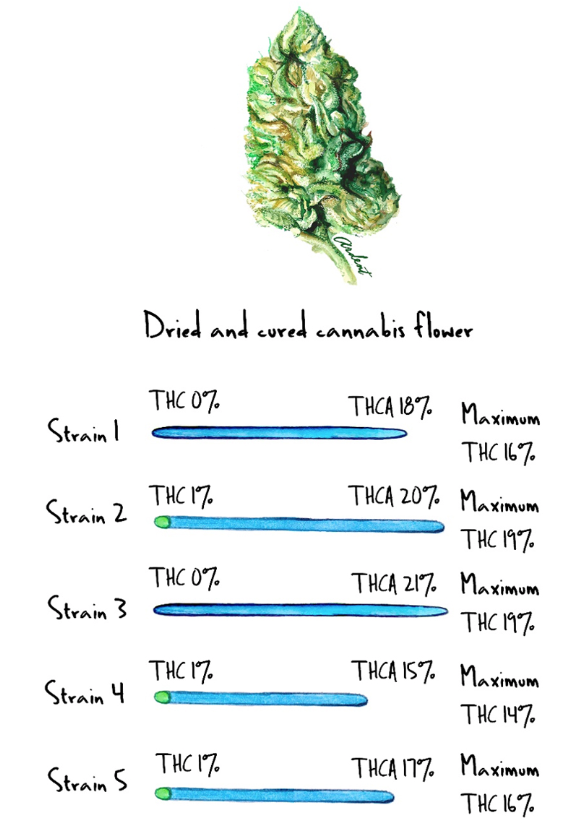
In the examples above, notice that proper curing never leads to a significant decarb of dried and cured cannabis flower.
The fact is, no more more than 1% THC is observed, while the average range is 0-6% of total available THC was fully decarboxylated.
Only when cannabis has been improperly stored (in a mason jar, for example) and exposed to bright light or high temperatures does it become slightly more decarbed. It is also possible that the plant goes through a degradation process if exposed to extreme sunlight. The decarb is nowhere near complete, even in extreme circumstances of exposure.
Fact: All bud, both fresh and cured, needs to get decarbed to be active and bioavailable. Decarbing fresh and well-cured bud involves the same process.
2. You Can’t Get More than 70% Decarb Before You Start to Destroy THC
This myth comes from one of the most widely promoted and most inaccurate decarb fables that stem from this often referenced, yet largely inapplicable graph.

For many years the inhabitants of the internet have treated this graph as gospel. A quick review readily shows why it’s not a reliable source.
First, it’s the decarb of a hexane extract in an open container on a hot plate. With this material in these circumstances, indeed, you can’t get a full Decarb without destroying THC (tetrahydrocannabinolic acid). However, we have come a long way from the early ’90s. We have more knowledge about the process of decarboxylation, the chemical reactions that occur during the process, and how to create the perfect environment for more efficient decarb.
Fact: We can do better than relying on an inapplicable graph from the early ’90s. And we know it’s possible to get a full Decarb without degradation. Keep reading to learn more.
3. It’s Easy to Decarboxylate Using What’s in Your Kitchen
It’s hard out there for patients who want to start decarbing cannabis, but are immediately bombarded with an array of different opinions on the best way to decarb. Most patients end up getting it wrong (resulting in wasted cannabis) and never stop struggling to find detailed instructions on how to get it right.
Any of these sound familiar?
- Crockpot for 3 hours… or, wait, is it crockpot for 12 hours?
- Tied down pressure cookers
- Monitoring ovens with laser thermometers
- Endless baking trays and parchment paper
Really, how can a patient NOT be overwhelmed? In the end, not one of these methods allows patients to safely and reliably get the most from their cannabis, and it’s important to understand why.
Crock Pot AKA Water Bath Method
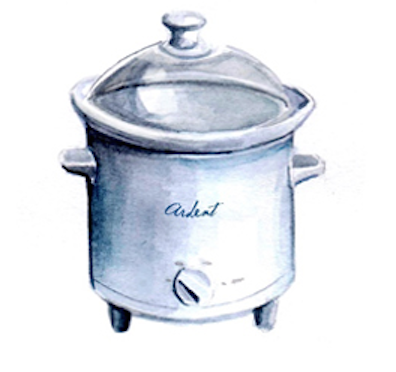

The crockpot is one of the most popular decarb methods. The idea behind using the crockpot/water bath method is that water boils at a constant temperature (212F) and provides better control than the fluctuations of the oven. Unfortunately, the comparatively low temperature of boiling water to other methods will never allow you to achieve a full, efficient decarb.
Decarboxylation at this temperature progresses slowly. Since decarboxylating is not a linear process (meaning that converting the tail end of THCA takes longer than the front end) we begin to see the degradation of plant material due to the excessive time exposed to heat.

Oven Decarb
Ovens aren’t designed for lab-grade precision heating. Temperatures fluctuate at an average of 10 degrees in either direction within an oven cavity.
For a process as sensitive as decarboxylation, these variations lead to either burning off cannabinoids or failing to fully activate. In either case, it’s a waste of valuable money and medicine.

Toaster Oven Decarb
Similar to the oven, the toaster oven’s lack of efficient temperature control is its downfall. Coupled with the appliance’s typical operation and the location of its heating elements, it can easily damage the bud or produce under-decarbed material. The toaster oven method makes it impossible to get reliable results consistently.
Nova Decarb
Equipped with advanced logic, dual sensor technology, and a hi-tech thermal blanket, Nova uses precision heating cycles to achieve fully decarboxylated cannabis without loss or degradation.

Fact: Kitchen appliances aren’t equipped to produce or maintain the conditions needed for full, reliable decarb, so we developed a device called the Nova to solve this problem.
4. Concentrate Decarboxylation is Different to Flower Decarb
(OR You Can Only Decarb Concentrate by Watching CO2 Bubbles Evaporate)
Concentrates that have been prepared professionally, extracted and purged under the right conditions have not been decarboxylated. They need to be properly activated before being ingested or used topically. The time and temperature parameters for the best flower decarb also applies to concentrates. As seen below, BHO extracts can become slightly more concentrated during decarb. This is likely from the evaporation of residual solvents and moisture.
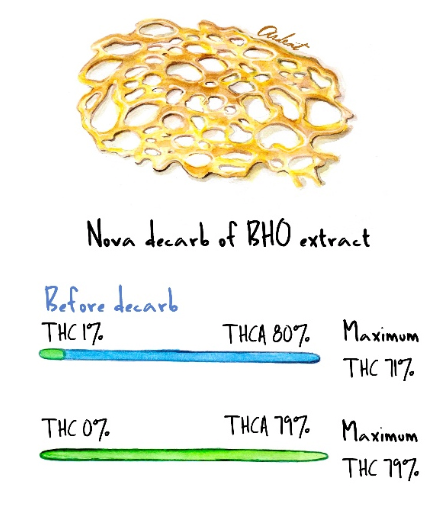
Like with properly cured and stored cannabis flower, properly prepared and purged concentrates have undergone little or no decarboxylation, with less than 5% of total THC decarbed.
Fact: Decarbing concentrate involves the same science as decarbing flower.
5. You Should Grind Weed Before Decarbing
Do you grind weed before or after decarbing? We suggest that you don’t grind before. This myth arose as an attempt to provide more even heating and combat temperature fluctuations when using the oven for decarboxylation. With precision decarb, there’s no need to disturb the trichomes by using a grinder. The Nova’s thermal blanket permeates the buds evenly, and intact buds provide more options for use post-decarb and increase the longevity of the material. All Nova tests were performed using non-ground material.

Fact: There’s no need to grind cannabis before precision decarb, and leaving the trichomes intact can increase shelf life.
6. Fats and Alcohols are Required to Decarb Cannabis
There is no doubt alcohol and fats can help prepare and administer cannabis in certain circumstances, and we’ll get to that. But to start, there’s an overemphasis on the role of alcohol or fat extraction that leads to patients unnecessarily spending hours, days, and even weeks preparing their medicine. It’s easy to understand the origins of this myth because it is based on science but often misapplied.

Cannabis is indeed fat and alcohol soluble. However, it’s not water-soluble. This means that THC won’t seamlessly bind and mix with a water-based substance, unlike the way it does with fat and oils.
Somehow, this fact has been twisted into an insistence that patients need to extract into butter and oils or use an alcohol-based solvent. Unfortunately for patients, these processes are complicated, time-consuming, and-in the end-inaccurate. It much easier for patients to activate cannabis flowers or kief and use it directly.
It’s possible to bypass all the hassle and prevent waste, while still getting the full benefits of whole plant therapy.
Direct activation and infusion give so many more options on how cannabis can be used and allows patients to quickly create accurately dosed topicals, sublinguals, and edibles. The instant substitute for hours of extraction is unnecessary. Take your desired dose of decarbed flower or kief and mix it with 1/2tb of good fat like coconut oil and enjoy. You can also substitute butter if you prefer.
When mixed with the active cannabinoids, the purpose of the fat is to help with absorption during digestion or topical application. Simply mixing your decarbed product with oil is a useful way to incorporate fats when dosing with cannabis.
Patients quickly realize that (thanks to precise decarb) so little flower or kief is needed to achieve results that direct infusion becomes as easy as sprinkling pepper on an entrée or adding vitamin powder to a smoothie. For patients who want butter or oil to use for canna culinary purposes, a quick extraction after decarb is all it takes for maximum ease and potency.
Fact: Fats and alcohol aren’t needed in order to decarb or administer cannabis, but they can be useful to pair with activated cannabis to aid in digestion and absorption.
FAQs on Decarbing Weed
What Can You Do With Decarbed Marijuana?
Now that you understand the myths of decarbing. Let us guide you on what you can do with your decarbed cannabis. A proper decarb gives you a fully activated flower, meaning you can use it as-is for:
- Sublinguals
- Smoking
- Edibles
- Tinctures
- THC Oils
- Pain salves
These are just a few options! If you want more ideas, read our article on our favorite ways to consume marijuana after decarb.
Don’t waste another ounce on a partial decarb. Get full activation with the Ardent FX or NOVA today.
About Ardent Founder
- Shanel A. Lindsay is founder of Ardent Cannabis and the creator of the Ardent house of products including the Nova decarboxylator and the FX all-in-one portable cannabis kitchen. She also helped write the Massachusetts adult-use cannabis laws and is the Co-Founder of MassEON (Equal Opportunities Now.)
- She is certain that with increased education, research, and reliable clinical data, patients and doctors—even those who have not previously considered cannabis as an option—will discover it is a legitimate, viable, and safe treatment.
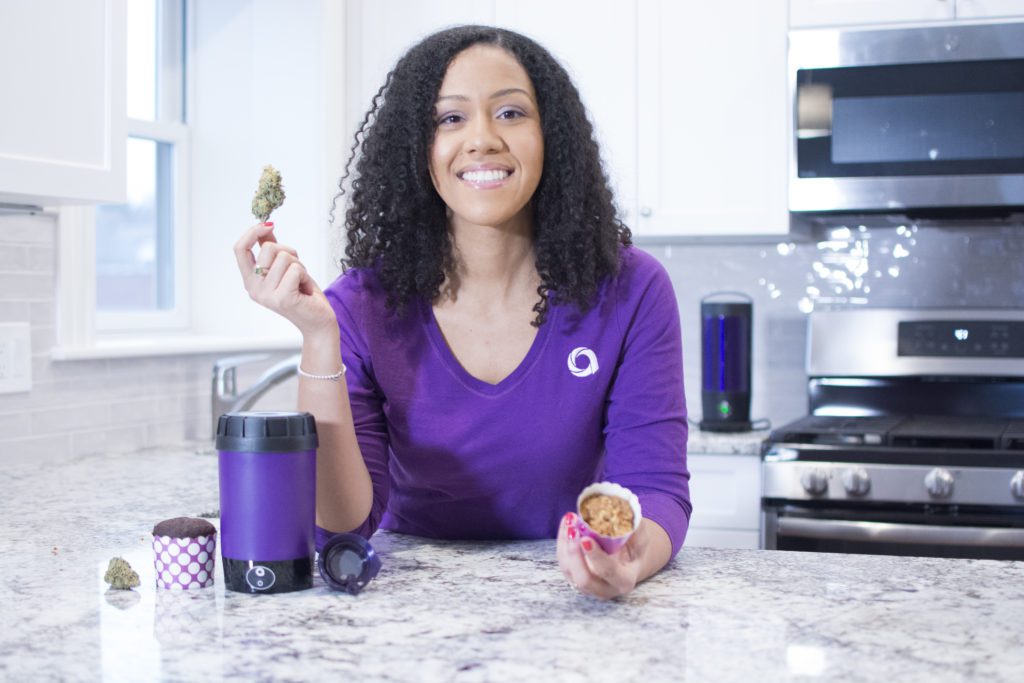
A special thanks to our testing provider, MCR Labs, who performed the HPLC testing outlined in this guide at their ISO accredited cannabis testing facility in Framingham, MA.
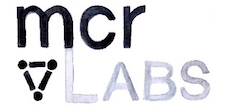







If I am Understanding this correctly I can decarbonate my weed use what I need and save the extra to use at a later date
Recently purchased, got great results with the NOVA.
I’m told decarboxilation will happen automatically while cooking, is that true?
Id say that is mostly false.
VERY little will- depending on oven temp and other variables – but technically yes some of the thca will convert to thc – take brownines for example- ground up fresh weed mixed in – Recipes call for oven temp 350 for brownies and while that temp is too hot for decarboxing and will destroy the thc the real problem is that the brownies themselves wont ever actually ever get to the 215-240 temp internally required to decarbox to begin with.
If you wait until the thermometer reads 240 and you let them sit at 240 for over an hour they will be solid bricks not brownies.
Hi Gary,
Although this would make the process much easier, unfortunately, this is not true. In order to get the most out of your herbal material, decarboxylation needs to occur prior to cooking.
Thanks for reaching out and please let us know if you have any other questions!
I purchased a NOVA Decarber some time back and I am thrilled with it! As I have continued to experiment with extractions for culinary purposes, I recently read about how blanching my flower in water could remove impurities and make for an overall cleaner finished product which is ideal for my culinary efforts. My question is how dry do I need to get my flower after I have blanched it before I place it in my NOVA to decarb? Should I strive to get it so dry as possible before placing it in my NOVA or is a little moisture from the blanching process ok? Would I need to adjust the amount of time, perhaps a cycle and a half, I decarb my blanched flower if it is still a bit moist from the blanching process?
Can you still smoke it after using the NOVA or is it just for cooking with
You can absolutely smoke and vape your cannabis after decarbing it! Decarbing is a required process for any cannabis product. A full decarb will give you a more potent product for your money, regardless of how you will be consuming. So if you will be smoking a joint, rolling it with decarbed bud will give you a more potent starting material and more mg’s of THC in your lungs.
You can make edibles with it, you can eat it by itself, and yes you can still smoke it.
I ordered my NOVA yesterday and I can’t wait!
I LOVE MY NOVA! My problem was all the different variables that can happen with home decarbing,
NOVA takes the guesswork out so no waste!
I can not praise this company and product enough. What the NOVA does to your herb you don’t have to understand the scientific lingo, you just have know it WORKS! It doesn’t make your weed taste burned or bad and the effect of your smoke after using the NOVA will make you wonder why hasn’t weed ALWAYS been Decarbed. Their customer service has to be the best on the planet. I’m so happy with my NOVA I only wish they had one that did larger amounts. If you use cannabis for any reason buy this product NOW!
Changed my life ..
CBD uses a different temperature than THC for decarb, can it handle CDB decarb?
Hi there,
You will find a full article that goes into many of our first findings with CBD!
https://ardentcannabis.com/cbd-sneak-peek/
The determining factor in CBDa decarb is actually whether THCa is also present. Where THCa is present, even where CBDa is dominant, CBDa and THCa will decarb simultaneously and at the precision temps that work for conversion to THC. It is only where THCa is minimal or not present that CBDa may require longer (2 cycle in the Nova or A2 cycle in the FX) processing.
This was really new information for many of our customers – So we made a video and about CBD activation and infusion along with testing results:
https://ardentcannabis.com/easy-cbd-decarboxylation-and-infusion/
I am 66 years old recovering from Cancer. can’t smoke ao i wanted to make some oil. After seen 2 videos on this and seen the lab test the only thing i can say is i wish i had the money to get one
I ordered my NOVA last week. This is the first time I have ordered anything with such a long shipping time. I can’t wait to get it.
Good day,
I am wondering how one should store decarbed weed and for how long it can be stored for.
Thanks!
Kasia
Hi Kasia,
We tested this exactly and the article can be found here: https://ardentcannabis.com/blog/what-is-the-shelf-life-of-decarbed-weed/
Thanks!
I like this, thank you. I recently found out that cannabis does not have to be *emulsified* to be decarbed. In fact,
I didn’t even know about decarboxylation. My curiosity just led me to find out about it online, and I realized that i
was going to so much trouble! So, I really identify with the benefits you explain, which I had to figure out the hard
way, haha. I think I’ll keep it a secret from the masses, so I can just be the lone edible-producing king, haha.
now i know whtasup next for christmas lol
Working with freshly harvested cannabis, do I need to release the steam during the process or just run it longer because it’s still damp at the end of the 2 hr cycle?
Hi There,
Depending of the moisture content of the flower, you may see some condensation when the cycle completes. But don’t fear, it has been decarbed and you are set to go!
As a matter of fact, you can actually decarb fresh flower right in the Precision Decarboxylator, with no additional steps! If you go to https://ardentcannabis.com/education/decarboxylation-myths and scroll down to Myth 1, you will see that this is, in fact, a very common misconception.
In fact, decarbing fresh flower is a good way to preserve more terpenes in the final product (think about the smell of fresh vs. dried flowers).
Please be aware that if you don’t dry the fresh flower prior to decarb it will come out wet. It can still be used in edibles and topicals but can’t be smoked. If you would rather your flower not be wet after the decarb make sure to dry it at least for a little bit, preferably at least a day or so. (I recommend trying it first with a very small amount so you can make sure you like this new-to-you texture 🙂
remove my name from email lists
not interested in product promotion was just looking for information
Hello, I have the NOVA and love it. I read an article recently that CBD needed a double carb. They recommended running the flower through the NOVA two cycles. Do you happen to know anything about that.?
Thanks in advance
Happy trails… Peg
Hi Peg!
All of our most current research about CBD so far can be found at https://ardentcannabis.com/education
There you will find a full article that goes into many of our first findings with CBD! — https://ardentcannabis.com/cbd-sneak-peek/
The determining factor in CBDa decarb is actually whether THCa is also present. Where THCa is present, even where CBDa is dominant, CBDa and THCa will decarb simultaneously and at the precision temps that work for conversion to THC. It is only where THCa is minimal or not present that CBDa may require longer (2 cycle in the Nova) processing.
This was really new information for many of our customers – So we made a video and about CBD activation and infusion along with testing results:
https://ardentcannabis.com/easy-cbd-decarboxylation-and-infusion/
What happens if you accidentally decarb in your machine twice?
Hey there!
The results if you decarb twice depend on the starting material of your flower!
If the flower is CBD, the following information will help:
All of our most current research about CBD so far can be found at
https://ardentcannabis.com/education
The determining factor in CBDa decarb is actually whether THCa is also present. Where THCa is present, even where CBDa is dominant, CBDa and THCa will decarb simultaneously and at the precision temps that work for conversion to THC. It is only where THCa is minimal or not present that CBDa may require longer (2 cycle) processing.
If the flower is mostly THC, the following information should help:
We find that some of our customers that are used to smoking or using ovens become quite accustomed to CBN rather then THC and notice the difference when this cannabinoid is less or not at all present.
To achieve similar levels of CBN as smoking or the over heating of an oven would you would simply need to over-decarb your product on purpose. To do this you would run the flower through one cycle with the unit – let the unit fully cool – and then run another cycle again.
The general idea is the more you overheat the higher levels of CBN and lower levels of THC you will achieve. We look forward to having more information on the exact levels at which the CBN rising and THC falls.
Hope this helps and feel free to reach out with any further questions.
Anyone ever try using an infrared oven for this? They are fairly precise and it’s harder to burn anything…..
Can the NOVA decarb a cube of hashish?
Hi Steve,
Yes both of our devices can decarb Hash!
Send me one I’ll try it an give review please and thank you
I was curious as to how long fully activated cannabis is good for? Does it have a shelf life or lose potency?
Hi there,
We wrote an article on this exactly! Please see the answer here: https://ardentcannabis.com/blog/what-is-the-shelf-life-of-decarbed-weed/
I just received mine yesterday. I tested it on the same strain ive been smoking for a week. After using the decarb. I packed a bowl and the difference was extremely noticeable. Absolute game changer!! Thank you.
Hello,
I froze trimmings and need to know about extra moisture that is left after decarbing. Some leaves look still pretty green. Your writing said it’s still decarbed?
Hi there,
Yes, that is correct, the leaves are still decarbed despite their appearance. Thanks!
Had this for 3 years and it works i can feel the difference in high and my weed lasts 2x as long best investment i made.
I accidently decarbed twice. What effect does this produce? I am concerned about negative outcomes. And as I am assuming my Ardent unit infuses my decarbed weed into coconut oil using the same exact heat exchange program for decarbing. What is the efficacy of this over choosing other typical home remedy heating options. My old way was to use my oven, a pizza stone for temp stability, a quality thermometer mounted in the oven, a candy thermometer submerged in my coconut oil and weed (2g weed/1oz oil) and baked at 210°F for 6 hours, stirring occassionally. The oil floated on a water base to seperate out the water soluble detritus. Anyways, I am hoping to make smaller more efficient quantities with your unit and could use some feed back on this. Thanks!
Hey there!
The results if you decarb twice depend on the starting material of your flower!
If the flower is CBD, the following information will help:
All of our most current research about CBD so far can be found at
https://ardentcannabis.com/education
The determining factor in CBDa decarb is actually whether THCa is also present. Where THCa is present, even where CBDa is dominant, CBDa and THCa will decarb simultaneously and at the precision temps that work for conversion to THC. It is only where THCa is minimal or not present that CBDa may require longer (2 cycle) processing.
If the flower is mostly THC, the following information should help:
We find that some of our customers that are used to smoking or using ovens become quite accustomed to CBN rather then THC and notice the difference when this cannabinoid is less or not at all present.
To achieve similar levels of CBN as smoking or the over heating of an oven would you would simply need to over-decarb your product on purpose. To do this you would run the flower through one cycle with the unit – let the unit fully cool – and then run another cycle again.
The general idea is the more you overheat the higher levels of CBN and lower levels of THC you will achieve. We look forward to having more information on the exact levels at which the CBN rising and THC falls.
Hope this helps and feel free to reach out with any further questions.
The only extract that you will find already de carved is called distillate, usually cost a bit more but I’d say definetly worth it. Very accurate dosing for both smoking and using as an edible.
Im interested in one!!!
Nice article. The product sounds like a valuable thing to have, but it seems very pricy for a small heating chamber, no?
Can concentrates be made with the Ardent?
Yes! You can decarb concentrates using either of our devices!
hi 🙂 bross 🙂
I got my Montana Medical card over a year ago and at first thought OMG I’m turning into one of those people who don’t get buzzed by “dope” (I use that euphemism for cannabis internationally) I can’t remember where I first saw decarb-ing mentioned but as a retired researcher I looked into the process more tried it out and made cannabis olive oil…. and used it to make popcorn or potcorn. Then proceeded to eat an entire bucket while watching television never realizing I was getting the munchies. Oh man, I was messed up. Yes I had greened out big time but realized I was in the safest place, bed. In between anxiety laden thoughts I would burst out into profound laughter once I talked myself off the proverbial ledge. “No Rhonda the plane flying over is not gonna crash into your house.” Yes decarbing is completely necessary, but you know this! Thank you Shanel for stepping up the cannabis game. I’m so happy to know of a woman of color involved. Being one myself, I stupidly thought I was a one woman “show”. Never been so happy to be WRONG.
Excited to receive my shipment of the Ardent. Love the video’s, thanks Shanell
First of all I would like to thank those individuals involved in the creation of this article as it addressed a number of excellent points. I have been involved in the scientific aspects of cannabis for 35 years and I could not concure more. Cannabis consumers, cannabis cultivators and cannabis processors are largely some of the most uninformed individuals that could possibly be associated with consumer products. It leaves one contemplating how we ever evolved into modern man. The lions share of information available regarding cannabis its cultivation, its processing for consumption and its medicinal benefits is simply inaccurate. The information available is based largely on assumptions, poorly derived theories, properly controlled studies and research and pure fabrication published for the purpose of selling or promoting useless (at best) products to uneducated consumers. I have seen the full range of morally and ethically unacceptable human behavior associated with the egoism and desire to somehow profit from any possible aspect of this plant. There is a growing anomie presently contributing to an existing stigma that has surrounded cannabis for decades. This stigma was the result of years of media propaganda programming . Ironically as sure as we begin to debunk the politically
derived fallacies that have negatively guided social preception for 80 years . A new generation of embellishers has emerged to give credence to a once purely exaggerated reality. Without having to look very hard it seems totally apparent to me.The most negative effect and damaging impact that cannabis has on humans is to their moral compass. Ingestion of the plant is not required. A rather profound discovery. There is what I call a wide spread “intentional ignorance” that coexists in parallel with a dysfunctional sense of self entitlement and self assumption within individuals that have had any direct or indirect history however related to this plant. Those who have smoked it are know it all critics. Those who have grown it are suddenly Master Botanist responsible for its existence and believe they actually own it. Those who have sold it are business moguls, skilled entrepreneur commidities brokers. Those who have trimmed it are super connected to serious organized people. Those who have studied it, are just like growers they have nothing left to learn. You can always tell a grower but you can’t tell them much. This in turn is what largely contributes to the fabrication and manipulation of factual information. People embellish their relationship with this plant. The greatest contributing factor to the abundance of bad information that is everywhere. Is the lack of scientifically supported data available for public consumption. It is because of this fact that many individuals just make things up. Because there is no available data to refute what it is they’re claiming. Those who knew a little bit about it when the vast majority knew nothing about it profited greatly from their knowledge. This has set the stage for the cannabis industry quagmire we are witnessing today. The evolution of cannabis clearly has a long way to go. But it has been freed from oppression and with individuals such as yourself and those that contributed to the production of your article educating readers . We can begin to creste a standard of information for educating society based on scientifically supported research and proven facts. Shorting the road for people that desire to become informed citizens and knowledgeable consumers.
Aidin Penn
I’m a machine operator by trade, and I think the Ardent is cooler than any million dollar machine I’ve ran 🤪
✌❤🤩
What is the shelf life of decarboxylated cannabis …..BTW love my machine
Hi There,
I am glad you asked. We did a whole article on this topic here: https://ardentcannabis.com/blog/what-is-the-shelf-life-of-decarbed-weed/
Enjoy!
I’m about 100 minutes into a decarb session and the light on my FX is flashing red. What the heck does that mean? I should expect the session to end soon and the light should turn into a solid green. Anybody know the status of the cycle when it’s flashing red? Nobody is answering the phone at Ardent today. HELP!
Hey there!
The flashing red light on the FX is the FX running the cool down cycle!
Once the light is solid green the unit is ready to be used again!
Hello
Thanks for this!
Thanks a lot
While these points are true, I hate when companies make up articles like this just to advertise their products. Just advertise your product 😂
I just recently came across this product line. Looks very promising, i’m going to check a few more reviews but I think I will be getting an Ardent FX.
What are the directions for decarbing concentrates ?
Hi David!
Thanks so much for reaching out to us.
You can decarb concentrates in your device the same way as you would bud or any other plant material! This is easiest with our new Silicone Concentrate and Infusion Sleeve: https://ardentcannabis.com/products/concentrate-and-infusion-sleeve/
Otherwise when decarbing concentrates you want to put your concentrate into one of the following 3 options:
A silicon container (making sure it is in fact silicon and not plastic)
A glass shot glass
Parchment paper, making sure you fold up all the edges so it will not leak out during the decarbing process
Once you have your concentrate in one of the above options, you simply place it in your device and decarb as you normally would.
Great product works well, does the job. This is the easiest and best way to work with cannabis, after having the experience I could never go back. So if you’re thinking about purchasing one go for it you’ll be glad you did.
Love my Nova!!
Yes you can decarb and then store it in an airtight container just like normal herb. It will be good to use later for sure. At Helenskinz NZ we always tell people to decarb without grinding first, then you should be able to “Crumble” your decarbed herb into a bowl ready to add to your infusion or cookie mix etc. It should come out Golden, smelly awesome and sticky to touch if decarbed correctly. It’s very hard to mess it up with any Ardent products, push one button and come back in 2 hours to find perfectly decarbed buds. Gotta love that!
Decarbing is so effective you can decarb some buds and crumble it into a bowl. Then you can use Gel Capsules that you can scoop into the decarbed herb and fill, assemble the capsule and store for later use. This is a pretty basic way to consume herb but it works, great for insomnia, take one before bed and it will peak at about 4 hours and taper off but will still be active in your body for up to 12 hours. That means you could sleep for 8+ hrs quite easily just using a small amount of decarbed herb. There are so many ways to do it but that is one way I kinda like. Check out our Ardent FLEX page on our New Zealand site, loads of info and images, vids etc.. Yep we went all out! The Ardent FLEX is a fantastic device, we have found the quality of the newer FLEX much better than the NOVA. It’s a great machine.
ARDENT FX – https://www.helenskinz.co.nz/products/ardent-nova-fx-all-in-one-decarboxylator-baking-butter-machine-220v-nz